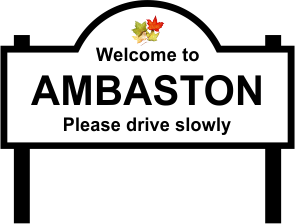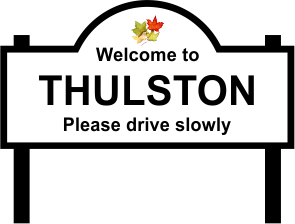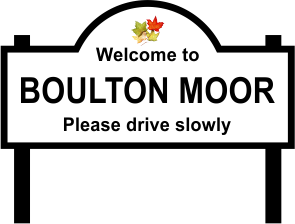Our Community Group encompasses a wide area
We welcome residents of the following areas..

Elvaston
The name of Elvaston was derived from the first recorded settlement of Aelfwald’stun, dating back to at least the 11th century. In the Doomsday Book it is referred to as Aleuuoldstune when it contained a church and a mill. By this time (1086) Elvaston was in the hands of Geoffrey Alselin and the land stayed in this family until it passed, by marriage, to the Bardolphs.
It later came into the hands of the Blounts and was finally passed by Henry VIII to Sir Michael Stanhope whose good fortune did not last as he was beheaded in 1552 at Tower Hill for treason. His grandson, Sir John, inherited the Elvaston Estate and largely rebuilt Elvaston Castle in 1633, part of which is apparent in the South East wing of the present building.
The seat of the Earls of Harrington
Elvaston became the seat of the Earls of Harrington in 1742 under William Stanhope. The 3rd Earl, Charles was a well respected military man and undertook major restoration of the house and gardens. The 3rd Earl’s eldest son, the Viscount Petersham was his successor in 1829 and he brought about sweeping changes and put Elvaston Castle’s gardens at the forefront of 19th century design. It came about because of the unusual synergy between the society dandy Lord Petersham, his mistress (later to be his wife) Maria Foote and the multi - talented young Scottish gardener – William Barron.
The first County Park in Britain
The gradual decay of the house and gardens, which had taken place after Barron’s departure, accelerated and they were finally sold in 1963 to Needler Corporation, followed by a sale of the contents of the Castle in 1964. An application for gravel extractionwas made by Derbyshire County Council and Derby Borough. In 1970 it was opened as the first Country Park in Britain.
St Bartholomew’s Church
Which is situated in the Country Park is listed Grade 1 and is in part 13th century with a chancel of c. 1200.
The original village of Elvaston was made up of mainly estate workers cottages, with a village school which is now the Elvaston Parish Hall. A war memorial stands at the corner of Silver Lane and bears the names of local men who died in the service of their country.
The Castle at the heart of the community.
Formal gardens and pleasure grounds were owned by Derbyshire County Council and in 1970 opened them as a Country Park
The estate was owned by Walter Blount, created Lord Mountjoy in 1465, but then it passed to Sir Michael Stanhope.The Stanhope family were created earls of Harrington in 1742 and the second Earl made Elvaston his principal seat.
The Stanhope family continued to live at Elvaston until the eleventh Earl moved to Ireland in 1939.
Ambaston
Ambaston is one of the oldest villages Derbyshire.
Its roots post-date the Roman era and its name derives from an Angle named Embold who chose the fertile flood plain site for farmland. His name gave rise later to a Domesday Book entry of Emboldstune; one of the three Manor house lands in the area. Ambaston also marked the northern limit of navigation along the then picturesque River Derwent.
The village became a collection of four tenanted farms and small holdings, which also tended orchards of apple trees and pear trees producing ‘perry’. It further evolved over time and in the early 19th century, it is recorded that the village also supported a butchers, carpenters, drapers and general shop, together with an Inn, (the first Harrington Arms in the Parish), a school and Wesleyan chapel (built in 1832). Disorderly behaviour by the local boatmen, and regular brawls outside the Inn led to its demise and it was eventually closed. The name ‘Harrington Arms’ being transferred to two cottages in nearby Thulston.
A ford crossed the Derwent to Draycott Fields which is signposted from the bridleway off ‘Cow Lane’, and can still be seen today when the river is at its lowest. Also a chain ferry crossed to Sawley (withdrawn in the late 1930’s) and was part of the well-used historic footpath (now the Derwent Valley Heritage Way) that went through the village to avoid Ambaston Marsh to the north.
Fertile land
Being located on the Lower Derwent flood plain, with a brook not far away (which still regularly overflows) accounted for the land’s fertility but also resulted in regular flooding of the village.
Residents often spoke of water being up to the handles of oven doors in kitchens, and of pigs and hens having to be rescued and housed in spare rooms until the flood water subsided. That, coupled with a change in the countryside socio-economics, and its location away from major routes, possibly led to a depopulation of the village in the early 20th century. Over half of the dwellings were unoccupied and in a state of ruin, with weeds and docks growing over the footpath and potholes in the road.
Operation Starfish
During WW2 Ambaston was abandoned to become one of the ‘Operation Starfish’ sites (dummy buildings and the use of fires) to decoy night-time enemy bombers away from the Rolls Royce factories. It was about this time that the chain ferry ceased to operate.
Improved post war personal mobility and, in the 70’s, a new 2m high protective Floodbank surrounding the hamlet rejuvenated interest in the area, being over a mile from other villages and having a no through road, it is now a sought after residential location comprising a mixture of 45 dwellings consisting of traditional cottages and newer properties.
As a non-sustainable village, i.e. no shops or other commercial premises or transport facilities, Ambaston will not grow in the foreseeable future, although new properties are being built on the footprints of some older ones.
(PHOTO) A damp day in Ambaston 1960’s Ambaston 2018
(PHOTO) Plan of Ambaston circa 1860 Google aerial view of Ambaston 2017
Thulston
The name Thulston derives from the Saxon name Torelfestune, one of the three hamlets belonging to Toschi during the reign of Edward the Confessor (1042 – 1066).
The Doomsday Survey
At the time of the Domesday survey the hamlets had passed into the possession of Geoffrey Alselin whose descendent Ralph Hanselyn founded the parish church. Hanselyn, was adopted as a road name in the village in the 1970’s.
Thulston remained as part of the Harrington estate with tied cottages and farms well into the 20th century.
The village had its own CoOp shop which was adjacent to the Harrington Arms, since demolished and a Post Office located on Yew Tree Lane.
This was originally opened in the 1850s, closed in the 1930s and demolished in the 1960s at the time of the road alterations.
The 1960s and 70s saw dramatic growth in the size of the village with developments to the rear of the Harrington Arms and in Grove Close. At the same time a village green was created and over 40 years later it is in the process of being adopted for the Parish.
The Harrington Arms
The Harrington Arms is a thriving public house and restaurant located at the centre of the village, drawing diners and drinkers from the wider community.
The pub was originally called the Bricklayers Arms, the Harrington Arms name was originally that of a hostelry in Ambaston which had a bad reputation for drunken and bawdy clientele. The Earl closed it and the name was transferred to Thulston.
Boulton Moor
In the year 550, boatloads of Angles from Schleswig – Holstein sailed up the Trent to settle in parts of England. Because it was in the middle of England, Derbyshire was almost the last part to be reached. And one of the Angles, Bola, must have taken a liking to the Boulton Moor area, for he founded a village here which became known as Bola’s – ton. ( Bola’s farm or settlement).
The changing name
As with most place names, spelling changed over the years Bola’s ton became: Boletune in the Domesday Book in 1086 when it belonged to Ralph FitzHubery, Boletun in 1176, Bolton in 1250 and Bowlton on a map of 1577.
The Boulton Moor of today is one of the four hamlets of Elvaston Parish and would hardly be recognisable to locals of only 30 years ago, and definitely not to one resident of 1892, when "James Holmes was fined 2s 6d or 7 days, for keeping a dog on Boulton Moor without a licence”. Many new houses have been built, with more in the pipeline.
In the gravel beneath their feet
It may be a little bizarre for the new owners to think that in the gravel beneath their gardens may lurk the fossilized remains of hippopotamus, rhinoceros, elephant, brown bear and bison for remains of all of those have been found here. In 1973 the fossils, which were well preserved, were found at a depth of 3 – 5m below the ground level in a sequence of fluvial sands and gravels. They were living during a warm interglacial period 130,000 to 70,000 years ago. Part of Boulton Moor is classified as a “site of special scientific interest” and is one of the most important in the Trent basin, providing a crucial link between the glacial and fluvial sequences in his valley.
The 1805 Enclosure Award Map
This shows most of Boulton Moor as being within Alvaston Parish with parts in Boulton Parish. Names of the fields hereabouts give a good indication of the nature of the land: Moor Field, Kelmoor, Moor Furlong and Nether Moor, with surrounding area names such as Whymill Moor, Sinfin Moor and Swing Moor. So the hamlet of Boulton Moor, once “home” to some of the oldest inhabitants of Elvaston Parish is now, due to the many hundreds of houses which have been built there in recent years, home to some of its newest.




